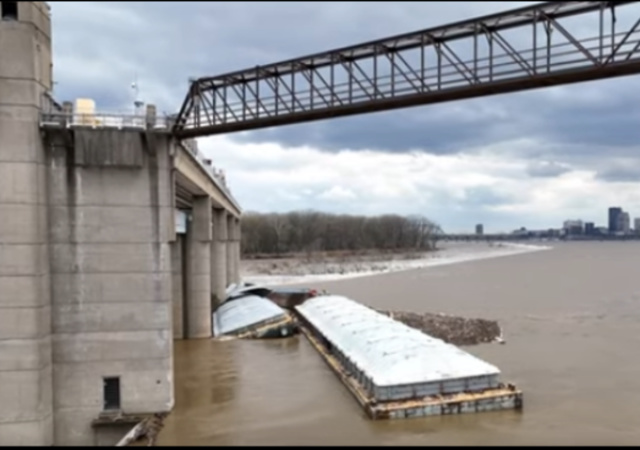Philadelphia Declares Water Safe After Chemical Spill in Delaware River
Meanwhile, loose barge carrying methanol partially submerged at dam in Louisville, KY,

Another significant chemical spill has impacted the lives of thousands of Americans.
This time, the hazardous materials release occurred in the Delaware River.
An estimated 8,100 gallons of a water-soluble acrylic polymer solution was released into the Delaware River outside Philadelphia late Friday night, just a few miles upstream of a key intake for the city’s Baxter water treatment plant.
The spill was the result of an “equipment failure” at a Trinseo PLC plant that makes acrylic resins, the owner said.
At least one of the leaked chemicals, butyl acrylate, is among the contaminants of concern identified in last month’s derailment of a train carrying hazardous materials in East Palestine, Ohio.
The city maintains that no contaminants have been found in any of Philadelphia’s water after Friday’s spill. The city water department previously said that any contamination would have cleared the area by Wednesday or Thursday.
The water has been declared safe by officials.
Philadelphia officials say the city’s water system will not be affected by a chemical spill into the Delaware River upstream last week.
“We can all confidentially say the threat has passed – I repeat: All the city´s drinking water is safe to drink and will not be impacted by the spill,” Mayor Jim Kenney said Tuesday night. Sampling hasn’t detected any substance from the spill, and “models tracking the flow and tide of the Delaware River show the potential threat is passing us,” he said.
The recommendations for drinking bottled water have been rescinded.
Testing determined there’s no contamination in the river near the intake for the city’s water system nor in the system itself, Michael Carroll, a city deputy managing director, said an a video news conference Sunday evening.
The intake had been shut down but reopened temporarily early Sunday to ensure the system had a minimum level of water to maintain pressure for firefighting and other uses, officials said.
In a notice Sunday night, the Philadelphia Water Department said tap water would be safe to drink through at least the end of the day Monday. Officials will provide updates on social media, they said.
It appears there may not be that much bottled water to buy in the area anyway.
Meanwhile in Philadephia, people went panic-buying of bottled water after contamination of major potable water sourcehttps://t.co/6DmW0chAzu
— Tonyo Cruz (@tonyocruz) March 28, 2023
Meanwhile, a set of locks for an Ohio River dam in Kentucky is closed due to a “navigational incident” after ten barges were released from a tugboat, including one barge carrying 1,400 tons of methanol.
The incident occurred at roughly 2 a.m. Tuesday, according to the U.S. Army Corps of Engineers. Of 11 total barges, 10 became loose from a tugboat; three barges became pinned to the dam, and one additional barge was pinned against a pier, the agency said.
The Army Corp of Engineers said it recovered the barge pinned against the pier by noon Tuesday. It wrote in a statement that the remaining six barges were recovered, adding that the dam’s locks will remain closed until the “barges on the dam are stabilized.”
The Kentucky Energy and Environment Cabinet said in a tweet that the barge carrying methanol is partially submerged at the McAlpine Locks and Dam in Louisville, Kentucky. The incident prompted Louisville Fire to deploy hazmat monitoring to the dam, according to a Louisville Metro Emergency Services representative.
“The barge companies are marshaling significant resources in response to the incident and will assess the situation and determine next steps,” the representative wrote. “In the meantime, Louisville Fire has deployed Haz-Mat monitoring and LMPD and LFD are surveying the area until the private company arrives on scene.”
Methanol occurs naturally and is even found in small quantities in the human body. However, the chemical is both highly flammable and potentially toxic. Direct ingestion of more than 10 mL (about 1/3 of an ounce) can cause permanent blindness by destruction of the optic nerve, poisoning of the central nervous system, coma, and possibly death.
Area officials have announced the water is safe to drink.
Louisville Water said it is aware of the situation, which is downriver from the water company’s intake.
“There is no impact to Louisville Water’s water intake or water quality,” they said. “Your water is safe to drink.”
One barge was pinned against the Louisville and Indiana bridge pier, it has since been recovered.
According to Kentucky’s Emergency Response Team, the nearest water intake is in Henderson, Kentucky.
“The U.S. Army Corps of Engineers is working closely with the U.S. Coast Guard, navigation industry and marine surveyors to start the recovery efforts of the remaining barges,” officials said.
The locks will remain closed until the barges on the dam are recovered.
 DONATE
DONATE
Donations tax deductible
to the full extent allowed by law.








Comments
Another transportation snafu under Pete’s watch. Hey, did you guys and gals know he’s gay? 😉
Why do the trains and barges and trucks and airplanes hate alphabet people so much?
It’s a long-standing feud between the people of the Island of Sodor and the Street of Sesame.
Milwaukee River used to be a dump site it was horrendous
Now it’s pretty pristine
The water is safe to drink because the chemicals killed off all of the germs. The brown color tells us that it is safe to drink. Yup.
I don’t want to sound paranoid, but this is almost beginning to look deliberate
Thank God! Dirty water might cause Philly to experience shockingly high crime rates and abysmally low school test scores.
Sure it is.
Declared “safe” by the FDA, or the CDC?
By the Department of Misinformation, of course.
But do they have a song?